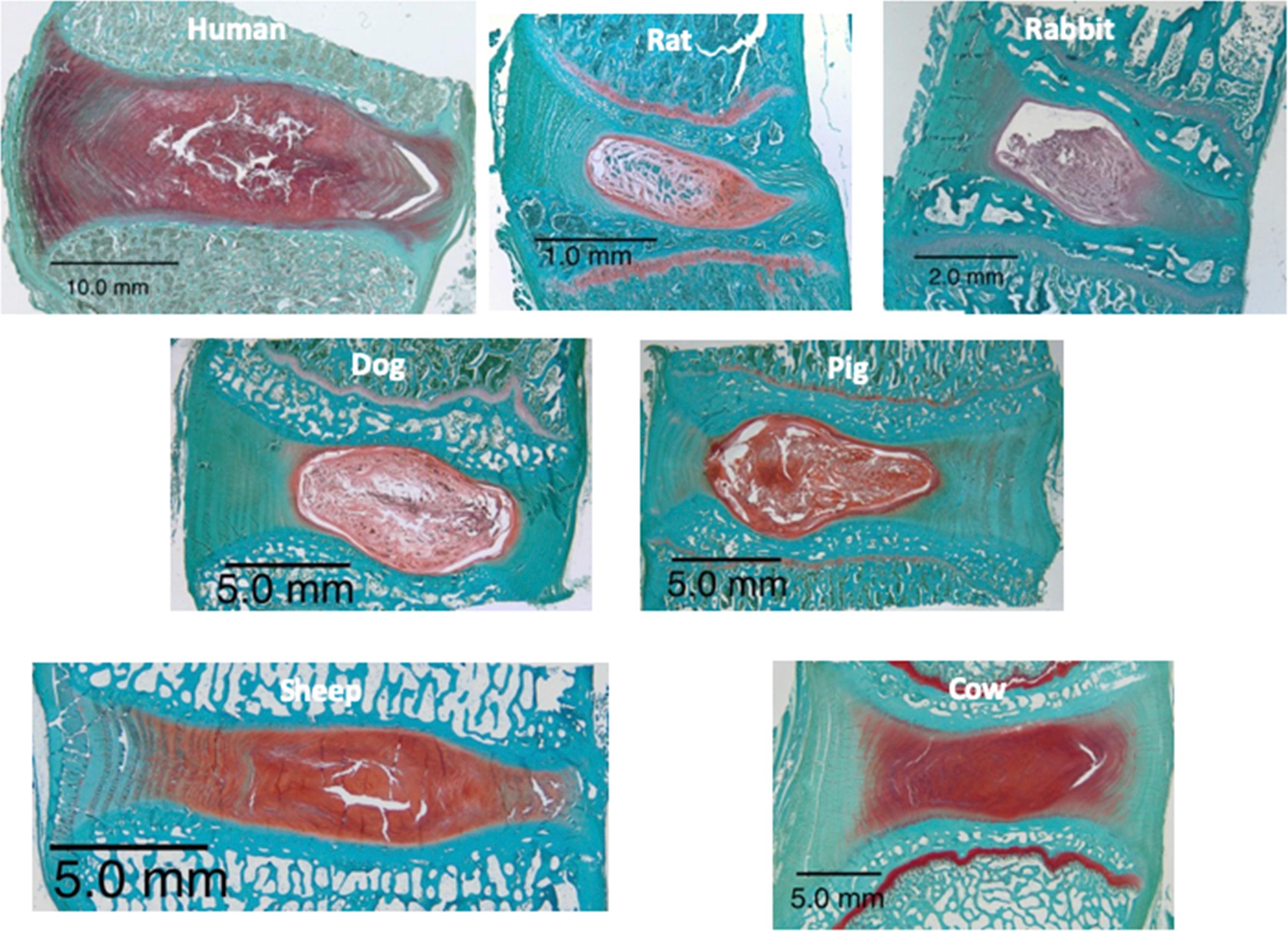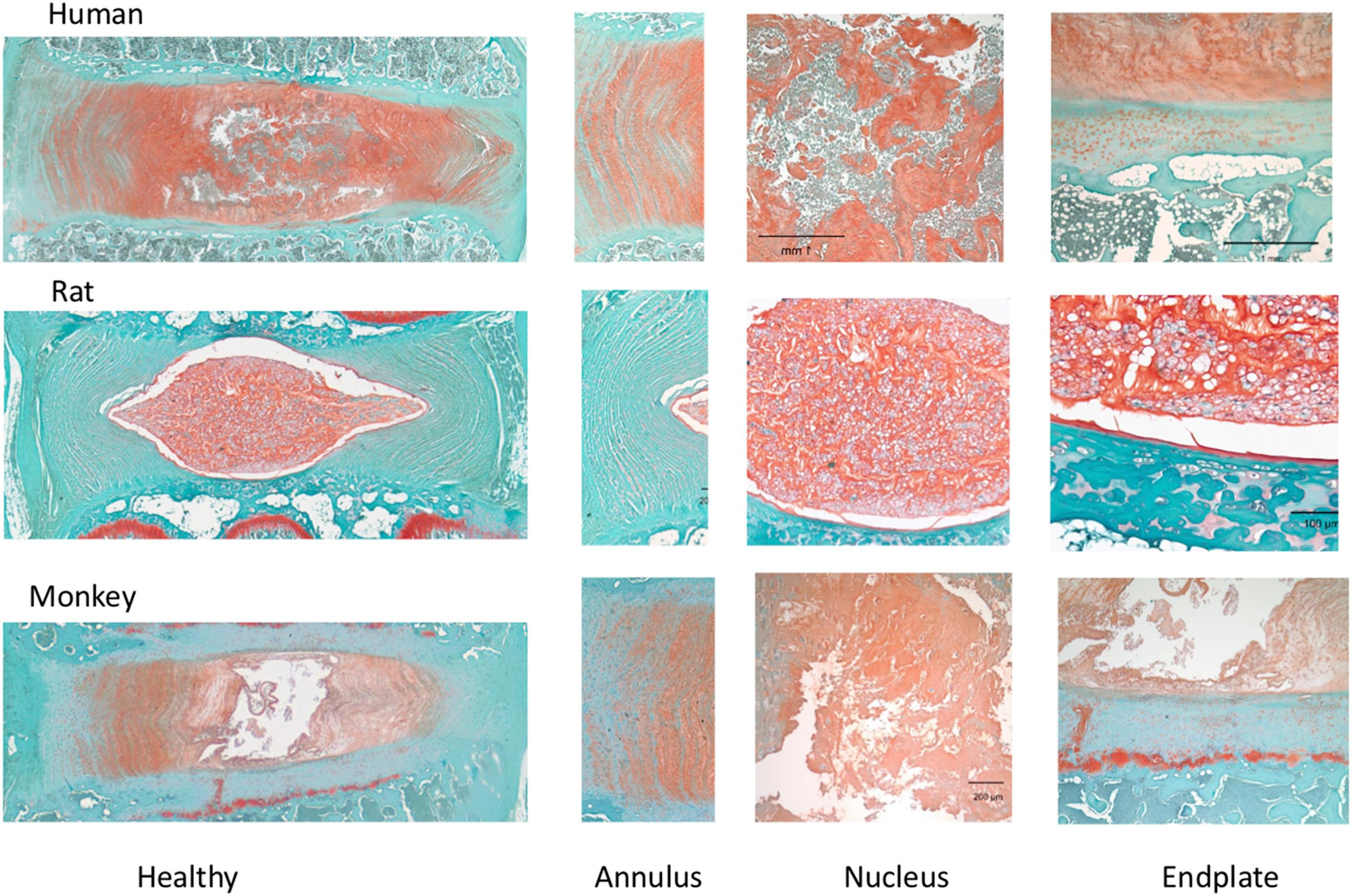Physical Address
304 North Cardinal St.
Dorchester Center, MA 02124
Animal models are critical for understanding disease mechanisms and developing new therapies.
Species differences in intervertebral disc size, tissue composition, and cellular content associate with distinct biomechanical and biological behaviors.
Some features of human disc degeneration are mimicked in animal model systems, but the absence of standardized methods for assessing, reporting, and comparing histopathologies of human and animal discs limits our ability to generalize mechanisms from animal models and clinical studies.
While the discs in large animals can approach the size of a human, the lack of validated pain outcomes creates barriers for solidifying the clinical relevance of animal models of degeneration and regeneration.
Animal models are important for understanding disease mechanisms and also serve as a central component of preclinical evaluation of treatments for intervertebral disc (IVD) degeneration-related back pain. Factors, such as physical stress, solute transport, immunity, and tissue spatial relationships undoubtedly influence the manner by which animal IVDs degenerate, either spontaneously with age or after induction with mechanical or chemical insult. Equally important are the phenotypic behaviors of IVD cells that may be species-specific and therefore different from human IVD cells. Therefore, while animal models are an important and necessary bridge between in vitro systems and human clinical studies, they must be applied and interpreted with thoughtful consideration of their limitations and relevance to the particular line of investigation.
A primary obstacle in using animal models for IVD degeneration/regeneration research is whether clinically relevant pathologies exist or can be induced. This is particularly important when testing IVD regenerative therapies, where a primary goal is to determine whether the product (cells, matrices, and/or growth factors) can stimulate a desirable disease-modifying activity within the inhospitable niche of the degenerating human IVD [ ]. If the disease model does not sufficiently mimic the human situation, then animal data may not reasonably forecast future clinical trial outcomes. This fact underscores the importance that the chosen animal model simulates the salient pathological, technical, and clinical features. The larger the discrepancy between the animal model and humans, the greater the risk that the therapy will be ineffectual or even harmful. This difficultly is compounded by the fact that we are still uncovering human IVD pain mechanisms and hence have not fully defined the desired disease-modifying activities for new therapies.
Many animal models have been investigated in attempts to clarify disease mechanisms [ ]. However, these are not necessarily appropriate for judging the quality of a regenerative response. Similarly, there is a diversity of animal models used for preclinical testing of bioactive IVD therapies [ ]. Yet, significant gaps between outcome measures in animals and pain mechanisms in humans muddle decision-making when designing preclinical studies. The purpose of this review is to summarize factors that should be weighed when considering an animal model for degeneration research or therapy development and validation.
Across the various species used for spine research, the IVD comprises the same basic subtissues: nucleus pulposus (NP), annulus fibrosus (AF), and cartilage endplate ( Figs. 4.1 and 4.2 ) (see Chapter 1 ). This is not surprising given the similar developmental origins and functional requirements to facilitate spine flexibility while supporting the load. However, species diversity, principally in size and bipedalism, leads to differences that can become significant in the context of IVD degeneration research and tissue engineering.


There is a tremendous range in IVD size across species. For example, IVD height can range between 0.25 mm for a mouse and up to 11 mm or more for a human ( Fig. 4.1 ; Table 4.1 ). However, when IVD height is normalized by width as a measure of shape, the differences from humans are less extreme and the range from 12% for mouse to 31% for sheep [ ]. Yet, these size differences have important biomechanical and biological consequences. Three centuries ago, Galileo proposed the Square-Cube Law, which states that as a structure's size increases, its volume (proportional to length cubed) grows faster than its surface area (proportional to length squared). For example, if an animal's IVD dimension is doubled, then the surface area is increased by a factor of four while the volume is increased by a factor of eight. In this example, the Square-Cube Law indicates that the larger IVD may carry twice as much stress but is required to support nutritionally four times as much tissue. Assuming that the same biomechanical and biological principles apply across species, then as animals become larger, IVD loading and/or the IVD itself needs to be modified for cellular homeostasis to be achieved.
| NP | AF | NP | AF | NP | AF | |||||
|---|---|---|---|---|---|---|---|---|---|---|
| Animal | Disc height (mm) | Disc area (mm 2 ) | Normalized compressive stiffness (MPa) | Normalized torsional stiffness (N-m/deg) | GAG per dry weight (μg/mg) | GAG per dry weight (μg/mg) | Water content (%) | Water content (%) | Collagen content per dry weight (μg/mg) | Collagen content per dry weight (μg/mg) |
| Human | 10.91 | 1925 | 9.95 | 0.087 | 466 | 161 | 81 | 72 | 16 | 103 |
| Calf | 6.09 | 1100 | 12.72 | 0.108 | 384 | 66 | 80 | 69 | 60 | 149 |
| Pig | 5.46 | 872 | 15.77 | 0.403 | 379 | 72 | 83 | 59 | 6 | 122 |
| Baboon | 5.97 | 808 | 9.36 | 0.127 | 971 | 333 | 80 | 66 | 19 | 110 |
| Goat | 4.28 | 670 | 7.2 | 0.084 | 335 | 25 | 84 | 66 | 19 | 53 |
| Sheep | 3.4 | 511 | 9.78 | 0.356 | 547 | 133 | 75 | 57 | 20 | 107 |
| Rabbit | 2.4 | 90 | 10.44 | 0.152 | 579 | 160 | 82 | 62 | 78 | |
| Rat lumbar | 0.77 | 11.85 | 5.09 | 0.04 | 384 | 47 | 82 | 65 | ||
| Mouse lumbar | 0.31 | 1.61 | 2.93 | 0.083 | ||||||
| Cow tail | 9.18 | 857 | 8.84 | 0.068 | 548 | 112 | 83 | 69 | 43 | 107 |
| Rat tail | 0.94 | 12.86 | 4.19 | 0.015 | 95 | 20.5 | 75 | 48 | ||
| Mouse tail | 0.44 | 0.095 |
Become a Clinical Tree membership for Full access and enjoy Unlimited articles
If you are a member. Log in here